Land transportation
兰德运输过程手册说明书
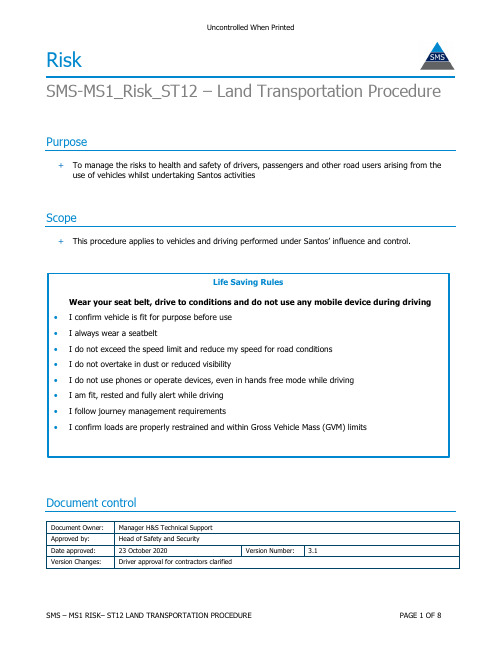
Uncontrolled When PrintedRiskSMS-MS1_Risk_ST12 – Land Transportation ProcedurePurpose+ To manage the risks to health and safety of drivers, passengers and other road users arising from theuse of vehicles whilst undertaking Santos activitiesScope+ This procedure applies to vehicles and driving performed under Santos’ influence and control .Document controlContents1Requirements (2)1.1Safe Driver and Journey (2)1.2Safe Vehicle (4)1.2.1Light Vehicles (4)1.2.2Heavy Vehicles (4)1.2.3Heavy Vehicles – Non Dangerous Bulk Liquid Loads (5)1.2.4All-Terrain and Utility Vehicles (5)1.3Vehicle Recovery (5)2Key Terms (6)Appendix A Santos Driver Training Requirements Flowchart (7)Appendix B Guide for Loading, Unloading Exclusion Zones (LUEZ) (8)1Requirements1.1Safe Driver and Journey1.Drivers must be licenced to drive in the class, type and configuration of the vehicle being driven2.Drivers must be trained and competent in the safe operation of vehicles. Refer to Appendix A fordetails on training requirements.3.Driver approval requirementsa.Drivers (employees and contractors) must be approved for driving. The intent of approvingdrivers is to minimise driving exposure through a focus on number of drivers. Drivers can beapproved for driving in field roads (Authorised drivers) or driving within plant and townboundaries (Restricted drivers).b.Santos workers driving a Santos vehicle, must be approved either as an authorised or a restricteddriver. Refer to Appendix A for details on approval and training requirements.i)Authorised driver – Santos worker who is required, as part of the duties they perform forSantos, to drive on sealed/ unsealed field roads. Approval must be provided their by Santoslevel two leader.ii)Restricted driver–Santos worker who is required, as part of the duties they perform for Santos, to drive within township/ plant boundaries and on sealed highways. Restricteddrivers are not permitted to drive on sealed/ unsealed field roads. Approval must beprovided by their Santos level two leaderc.Approved drivers must be issued with a personal IVMS keys. Drivers must only use their personalIVMS keys and must not use generic IVMS keysd. A system must be established to monitor IVMS exceptions and feedback driver behaviour andperformance4.Seat belts must be worn by all occupants whenever a vehicle1 is in motion, including reversing5.Drivers must travel at speeds appropriate to the conditions6.Speed limits must not be exceeded:a.sealed roads – travel at speeds up to the sign posted speed limitb.unsealed roads – 60km/h maximum, unless signposted lower7.Drivers must be fit to drive+Refer to MS14-ST08 Drug and Alcohol Procedure for requirements on impairment by alcohol, illegal substances and medication+Refer to MS1-ST15 Fitness for Work and Fatigue Management for fatigue requirements8.All journeys must be planned for safe arrival considering fatigue management, off-road driving, nighttime driving and emergency response requirements, and must include the following requirements:a.drivers of light vehicles must rest for 15 minutes after every two hours of drivingb.field operations must define and implement requirements for reporting and recording vehiclemovements and actions to be taken when a traveller is recorded as overduec.any need for additional vehicle lighting9.Water crossings must only be undertaken where there is no practicable alternative and the hazardshave been assessed as safe to cross. As a minimum water crossing must;a.Not be undertaken when the depth of water is more than 300mm in the depth marker. Watercrossing must not be undertaken if the depth cannot be accurately assessedb.Not be undertaken is the flow rate is more than 2 m/s at 300mm., Rule of thumb, no wakeevident around trees/ posts)c. Only be undertaken if the condition of the surface is known to be sound10.Overtaking another vehicle is prohibited when driving in dust or other situations of reduced visibility11.Four wheel drive must be engaged, where fitted, when driving on unsealed roads and off road12.Cruise control must not be used when driving on unsealed roads or in wet conditions13.Drivers must stop in a safe location, prior to interacting with a mobile device2. This includes making orreceiving phone calls and sending/reading messages, regardless if ‘hands free’.14.All light vehicles must reverse park or use drive through parks (i.e. forwards facing oncommencement of journey)15.Where vehicles are fitted with IVMS, a system must be established to monitor and feedback driverbehaviour and performance16.Drivers must only use their personal IVMS keys and must not use generic IVMS keys17.Tampering of IVMS system is prohibited1Not mandatory in golf cart type vehicles2Excludes oral communication using 2-way radios fitted to vehicles1.2Safe Vehicle1.Vehicles must be:a.inspected regularly (considering the type of vehicle, roads and journeys being undertaken) tocheck they are in a suitable condition to driveb.maintained in keepi ng with manufacturer’s guidance2. A vehicle’s safe loading limit, inclusive of passengers, must not be exceeded3.Loads must be restrained internally and externally to reduce the risk of vehicle instability from loadshifting or injury from projectiles4.When using lifting equipment to load or unload from vehicles, loading and unloading exclusion zones(LUEZ) must be used at all times during loading/unloading activity associated with a vehicle inaccordance with Appendix B. Refer to MS01-ST08 Lifting Operations Procedure for more information.5.IVMS devices must be installed in light and heavy vehicles that are driven on field roadsa.IVMS devices must meet the Safer Together In-Vehicle Monitoring Systems SpecificationsStandard Version 011.2.1Light Vehicles6.All Santos light vehicles procured after 1 December 2019 must comply with the Safer Together LightVehicle Specification Version 01 31.2.2Light Vehicle Trailers7.Light vehicle trailers must comply to the following:a.light vehicle trailers must not exceed 2.5m in overall width and the overhang distance from axle tothe rear of the load is not to exceed 2.5mb.in cases where the carried load projects greater than 1.2m from the rear of the trailer, a flag mustbe fitted to warn of this hazardc.dual axle trailers should be selected where possibled.dual safety chains must be fitted when trailers are in usee.light vehicle trailers with a gross trailer mass (GTM) of greater than 0.750 tonnes must have acompatible brake system fittedf.where the GTM exceeds 2 tonnes, the braking system must be fitted with a breakaway system thatcauses the brakes to be applied if the trailer becomes disconnected from the towing vehicle Note: Trailers with a GTM of less than or equal to 0.75 tonnes do not require brakes to be fitted.1.2.3Heavy Vehicles8.All Santos heavy vehicles procured after 1 December 2019 must meet the Safer Together HeavyVehicle Specification Version 03 33Santos is transitioning to the Safer Together light vehicle specifications in line with fleet replacement strategy. Target compliance for vehicle specification is December 2022.1.2.4Heavy Vehicles – Non Dangerous Bulk Liquid Loads49.Heavy vehicles and trailers designed to carry non-dangerous bulk liquid loads must be sized anddesigned such that slosh is minimal1.2.5All-Terrain and Utility Vehicles10.Quad bikes (or similar) are prohibited under all circumstances11.Other utility or side-by-side type vehicles (excluding golf cart type vehicles) must meet the followingminimum safety specification:a.bench or bucket type seating with seat beltsb.steering wheel and foot operated brake and acceleratorc.roll-over protection12.When using utility or side-by-side type vehicles:a.helmets that comply with AS1698:2006 Protective helmets for vehicle users must be worn:i)at locations within a gazetted (legal) road or road-related areaii)in other locations when travelling at speeds in excess of 20km/hb. a radio or other means of communication must be carried1.3Vehicle Recovery1.Only workers that are trained and competent may perform light vehicle recovery. Refer to Appendix Afor details on training requirements.2.When using a second vehicle for recovery, workers must:a.undertake a documented risk assessment for each recoverye only original equipment manufacturer-approved recovery pointse task-specific recovery equipment that meets or exceeds applicable Australian Standards3.Recovery of a bogged vehicle (where wheels are not moving freely) using a tilt tray truck by a Santosemployee is prohibited under all circumstances.4Requirements for liquids that are Dangerous Goods (e.g. crude oil) are detailed in the Australian Code for the Transport of Dangerous Goods by Road and Rail (ADG Code)2Key TermsTerm or acronym DefinitionAggregate trailer mass (ATM) The total mass of the trailer when carrying the maximum load recommended by the manufacturer. This will include any mass imposed onto the towing vehicle.Field road A field road is any road or track within a Santos area of operations that may be a public or private road. The road or track may have a natural or bitumen(or similar) surface. This excludes plant and town boundaries.Gross trailer mass (GTM) The maximum loaded mass transmitted to the ground by the axle, or axles, of the trailer when coupled to a towing vehicle.Except for semi-trailers, the difference between the ATM and GTM is usuallysmall.Gross vehicle mass(GVM)The maximum loaded mass of a motor vehicleHeavy vehicle A vehicle that with a gross vehicle mass (GVM) or aggregate trailer mass of more than 4.5 tonnes. The GVM of a vehicle is the maximum it can weighwhen fully loaded, as specified by the manufacturer.Light vehicle A vehicle with a gross vehicle mass (GVM) not more than 4500kg, not including motorbikes, bicycles and tricyclesLUEZ Loading/unloading exclusion zoneOff-road Driving associated with travel on unformed roads, including but not limited to, traversing pipeline easements, site scouting and seismic activities. Off roaddriving does not include formed unsealed roads leading to Santosassets/facilities (e.g. well pad access tracks).Santos worker Any person who performs work, or provides services, in any capacity for, or on behalf of, Santos, including all of the following:(a)employee, officers and directors(b)contractors, agents, consultants and subcontractors(c)apprentices, trainees, secondees, students gaining work experience andvolunteersVehicle Includes heavy and light vehicles but excludes mobile plant (e.g. forklifts and cranes, scissor lifts). Refer to MS01-ST08 Lifting Operations Procedure formore information about mobile plant used for lifting.Road-related area An area that divides a road, a footpath or nature strip adjacent to a road, car parks and any shoulder of a roadAppendix A Driver Training and Approval Requirements1.Santos Workers must hold the minimum qualifications and approvals defined in the table below.Table 1. Minimum qualification for Santos Worker5This refers to highways and not field roads (e.g. if the drivers are only required to undertake journey from Whyalla to Port Bonython or Roma to Injune). Driving on sealed field roads is hazardous. Drivers on sealed field roads must be authorised drivers.6 Town boundaries refer to driving within a hub (e.g. Moomba town fence)7 Contractors driving their own vehicles must be qualified in PMASUP236B or RIIVEH305E or their equivalent with a 5 year refresh period. Contractors need to complete Santos Safe Drive online module.8 Contractors driving their own vehicles must be qualified in PMASUP236B or RIIVEH305E or their equivalent with a 5 year refresh period. Contractors need to complete Santos Safe Drive online module.9 This course does not cover recovery using tilt-tray truck. Refer Section1.3, requirement 3.Appendix B Guide for Loading/Unloading Exclusion Zones (LUEZ)Green zone SAFE! Safe zone must be positioned to enable loading/unloading operator to maintain visual contact whilst operating loading/unloading equipment. Red zones DANGER!No one must be in the red zone while machinery is operating. A truck driver or any other person can only enter the exclusion zone when instructed clearly by the machine operator.The same system applies when loading in non-painted areas. Consider using fences, cages, barriers, truck gates, barricades, bollards, tape, chains, etc.。
货代英语
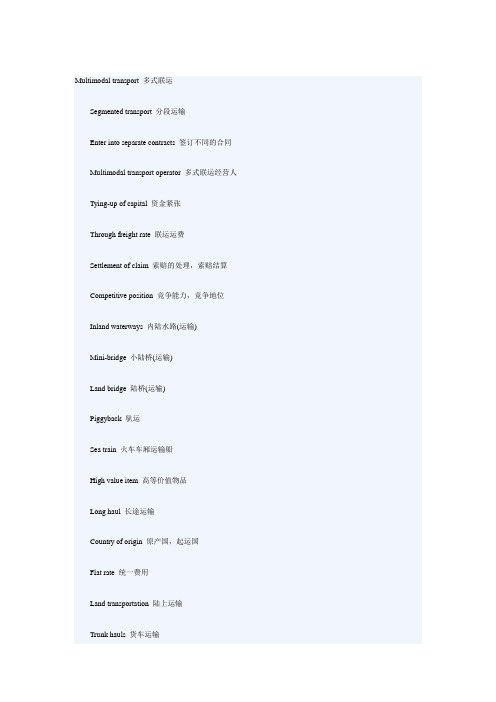
Multimodal transport 多式联运Segmented transport 分段运输Enter into separate contracts 签订不同的合同Multimodal transport operator 多式联运经营人Tying-up of capital 资金紧张Through freight rate 联运运费Settlement of claim 索赔的处理,索赔结算Competitive position 竞争能力,竞争地位Inland waterways 内陆水路(运输)Mini-bridge 小陆桥(运输)Land bridge 陆桥(运输)Piggyback 驮运Sea train 火车车厢运输船High value item 高等价值物品Long haul 长途运输Country of origin 原产国,起运国Flat rate 统一费用Land transportation 陆上运输Trunk hauls 货车运输Door-to-door 门到门7、Sea train 火车车厢运输船英文原文:Sea train is another innovation in the multimodal transport system involving the use of rail and ocean transport. It is similar to the roll-on, roll-off system except that in the place of the ro-ro vehicle a rail car is used so that geographically separated rail systems can be connected by the use of an ocean carrier.注释:innovation: 改革,创新be similar to: 类似于Roll On-Roll Off System:指将有轮子的货物,如汽车、火车车厢等从船体上装着的斜坡上滚上滚下的装运系统except that : 除了…之外ro-ro:=roll on-roll off vehicle: 车辆,运载工具rail car: 机动轨道车geographically: 地理上,布局上separate: 分开,分离中文意思:火车车厢运输船是另一个多式联运系统的创新,它联合了铁路和海洋运输。
商贸物流英语-运输方式

Ocean transportation is suitable for large volumes of goods and materials that are not sensitive to time, such as raw materials, finished products, and heavy machinery. It is also suitable for goods that need to be shipped long distances, such as from China to Europe or from the United States to Australia.
Business Logistics English - Transportation Method
Introduction to Transportation Methods land transportation Maritime transportation air transport Combined transportation
Coastal transportation
Inland waterway transportation is the transportation of goods and materials on rivers, canals, and other inland waterways, using barges or ships specifically designed for this purpose. It is commonly used in countries with extensive inland waterways, such as China and the Netherlands. Inland waterway transportation is usually less expensive than both ocean and coastal transportation because it does not require the use of large freighters or transshipment at ports. It is also environmentally friendly because it does not generate as much air and noise pollution as road transportation. However, it is limited by the availability of inland waterways and canals.
办公常用英语汇总:Transportation(Air ,Ocean ,Land) 交通运输(空、海、陆)(2)

美联英语提供:办公常用英语汇总:Transportation(Air ,Ocean ,Land) 交通运输(空、海、陆)(2)两分钟做个小测试,看看你的英语水平/test/waijiao.aspx?tid=16-73675-01.acrophobia 恐高症2.airliner 大型客机3.aviation 飞行;航空学4.cabin 小屋;客舱;机舱muter 通勤者6.conveyance 运输;交通工具7.crossroads 十字路口8.ferry 渡轮9.freight 货运;货物10.intersection11.jeopardy 风险;危险;危难12.life vest 救生衣13.pedestrian 行人;步行者14.restriction 限制;约束15.runway 飞机跑道16.shortcut 近路;捷径17.take off 起飞18.timetable 时间表;时刻表19.transport 运输;交通工具;运输系20.via 经由;借由十二.购物shopping (1)1.affordable 负担的起的2.bazaar 市场;集市3.client 顾客;委托人4.customer 顾客;客户5.discount 折扣6.distributor 供应商;经销商7.expiration 终结;期满8.itemize 详细列举;分条列举test 最新的10.neon sign 霓虹灯招牌11.pickpocket 扒手12.pushcart 手推车13.receipt 收据14.reimburse 偿还;补偿15.request 请求;要求16.sample 样品;样本17.solicit 请求;恳求;祈求18.trendy 时髦的;流行的19.VIP=very important person 贵宾20.wholesale 批发的;批发地购物shopping (2)1.bargain 便宜货;廉价品2.cash register 手银机3.coupon 折价券;赠奖券4.defective 有毛病的;有问题的,有瑕疵的5.display 陈列;展示品6.drugstore 兼卖杂货的药房7.flea market 跳蚤市场bel 标签;标记9.modify 修改;变更10.patron 顾客;赞助人11.purchase 购买;购得之物12.quantity 量;数量13.refund 退款;退还;赔偿14.replacement 代替;替换15.retailer 零售商16.shopping mall 大型购物中心17.thrift 节俭;节约18.vender 小贩19.warranty 保证;保证书20.workmanship 技巧;手艺。
货运英语名词

货运英语名词运输transportation | | transit | | conveyance运送to transport | | to carry | | to convey运输业transportation business | | forwarding business | | carrying trade运输代理人a forwarding agent承运人a freight agent | | a carrier船务代理人a shipping agent陆上运输transportation by land海上运输transportation by sea货物运输goods traffic | | freight traffic | | carriage of freights | | carriage of goods 货轮cargo boat | | freighter | | cargo steamer | | cargo carrier火车goods-train | | freight-train卡车goods-van | | goods wagon | | freight car | | truck货运办公室goods-office | | freight-department运费率freight | | freight rates | | goods rate运费carriage charges | | shipping expenses | | express charges车费cartage | | portage运费预付carriage prepaid | | carriage paid运费到付carriage forward | | freight collect运费免除||免费carriage free协定运费conference freight | | freight rate运费清单freight account托运单way-bill | | invoice运送契约contract for carriage装运shipment | | loading装上货轮to ship | | to load | | to take on a ship装运费shipping charges | | shipping commission装运单||载货单shipping invoice装运单据shipping documents大副收据mate's receipt装船单shipping order提货单delivery order装船通知shipping advice包裹收据parcel receipt准装货单shipping permit租船契约charter party租船人charterer程租船||航次租赁voyage charter期租船time charter允许装卸时间lay days | | laying days工作日working days连续天数running days | | consecutive days滞期费demurrage滞期日数demurrage days速遣费despatch money空舱费dead freight退关short shipment | | goods short shipped | | goods shut out | | shut-outs 赔偿保证书(信托收据) letter of indemnity | | trust receipt装载loading卸货unloading | | discharging | | landing装运重量shipping weight | | in-take-weight卸货重量landing weight压舱ballasting压舱货in ballast舱单manifest船泊登记证书ship's certificate of registry航海日记ship's log船员名册muster-roll(船员,乘客)健康证明bill of health光票clean bill不清洁提单foul bill有疑问提单suspected bill1. Off 关2、On 打开( 放)3、Open 营业4、Pause 暂停5、Stop 关闭6、Closed 下班7、Menu 菜单8、Fragile 易碎9、This Side Up 此面向上10、Introductions 说明11、Business Hours 营业时间12、Office Hours 办公时间13、Entrance 入口14、Exit 出口15、Push 推16、Pull 拉17、Shut 此路不通18、One Street 单行道19、Keep Right/Left 靠左/右20、Buses Only 只准公共汽车通过21、Wet Paint 油漆未干22、Danger 危险23、Lost and Found 失物招领处24、Give Way 快车先行25、Safety First 安全第一26、Filling Station 加油站27、No Smoking 禁止吸烟28、No Photos 请勿拍照29、No Visitors 游人止步30、No Entry 禁止入内31、No Admittance 闲人免进32、No Honking 禁止鸣喇叭33、Parking 停车处34、Toll Free 免费通行35、F.F. 快进36、Rew. 倒带37、EMS (邮政)特快专递38、Insert Here 此处插入39、Open Here 此处开启40、Split Here 此处撕开41、Mechanical Help 车辆修理42、“AA”Film 十四岁以下禁看电影43、Do Not Pass 禁止超车44、No U-Turn 禁止掉头45、U-Turn Ok 可以U形转弯46、No Cycling in the School校内禁止骑车47、SOS 紧急求救信号48、Hands Wanted 招聘49、Staff Only 本处职工专用50、No Litter 勿乱扔杂物51、Hands Off 请勿用手摸52、Keep Silence 保持安静53、On Sale 削价出售54、No Bills 不准张贴55、Not for Sale 恕不出售56、Pub 酒馆57、Cafe 咖啡馆、小餐馆58、Bar 酒巴59、Laundry 洗衣店60、Travel Agency 旅行社61、In Shade 置于阴凉处62、Keep in Dark Place 避光保存63、Poison 有毒/毒品64、Guard against Damp 防潮65、Beware of Pickpocket 谨防扒手66、Complaint Box 意见箱67、For Use Only in Case of Fire 灭火专用68、Bakery 面包店69 Seat by Number 对号入座70、Information 问讯处71、No Passing 禁止通行72、No Angling 不准垂钓73、Shooting Prohibited 禁止打猎74、Keep Dry 保持干燥75、Protect Public Propety 爱护公共财物76、Men“s/Gentlemen/Gents Room 男厕所77、Women“s/Ladies/Ladies“ Room女厕所78、Wipe Your Shoes And Boots请擦去鞋上的泥土79、Ticket Office(or :Booking Office)售票处80、Visitors Please Register 来宾登记81、Occupied (厕所)有人82、Vacant (厕所)无人83、Commit No Nuisance 禁止小便84、Net(Weight) 净重85、Admission Free免费入场86、Bike Park(ing) 自行车存车处87、MAN:25032002 生产日期:2002年3月25日88、EXP:25032002 失效期:2002年3月25日89、Handle with Care 小心轻放90、Save Food 节约粮食91、Save Energy 节约能源92、Children and Women First 妇女、儿童优先93、Dogs Not Allowed 禁止携犬入内94、Road Up. Detour 马路施工,请绕行95、Reduced Speed Now 减速行驶96、Keep Away From Fire 切勿近火97、Luggage Depository 行李存放处98、Take Care Not to Leave Things Behind 当心不要丢失东西99、Please Return the Back After Use 用毕放回架上100、Keep Top Side Up 请勿倒立[推荐]船务术语简缩语(1)FCA (Free Carrier) 货交承运人(2)FAS (Free Alongside Ship) 装运港船边交货(3)FOB (Free on Board) 装运港船上交货(4)CFR (Cost and Freight) 成本加运费(5)CIF (Cost,Insurance and Freight) 成本、保险费加运费(6)CPT (Carriage Paid To) 运费付至目的地(7)CIP (Carriage and Insurance Paid To) 运费、保险费付至目的地(8)DAF (Delivered At Frontier) 边境交货(9)DES (Delivered Ex Ship) 目的港船上交货(10)DEQ (Delivered Ex Quay) 目的港码头交货(11)DDU (Delivered Duty Unpaid) 未完税交货(12)DDP (Delivered Duty Paid) 完税后交货主要船务术语简写:(1)ORC (Origen Recevie Charges) 本地收货费用(广东省收取)(2)THC (Terminal Handling Charges) 码头操作费(香港收取)(3)BAF (Bunker Adjustment Factor) 燃油附加费(4)CAF (Currency Adjustment Factor) 货币贬值附加费(5)YAS (Yard Surcharges)码头附加费(6)EPS (Equipment Position Surcharges) 设备位置附加费(7)DDC (Destination Delivery Charges) 目的港交货费(8)PSS (Peak Season Sucharges) 旺季附加费(9)PCS (Port Congestion Surcharge) 港口拥挤附加费(10)DOC (document charges) 文件费(11)O/F (Ocean Freight) 海运费(12)B/L (Bill of Lading) 海运提单(13)MB/L(Master Bill of Lading) 船东单(14)MTD (Multimodal Transport document) 多式联运单据(15)L/C (Letter of Credit) 信用证(16)C/O (Certificate of Origin) 产地证(17)S/C (Sales Confirmation)销售确认书(Sales Contract) 销售合同(18)S/O (Shipping Order)装货指示书(19)W/T (Weight Ton)重量吨(即货物收费以重量计费)(20)M/T (Measurement Ton)尺码吨(即货物收费以尺码计费)(21)W/M(Weight or Measurement ton)即以重量吨或者尺码吨中从高收费(22)CY (Container Yard) 集装箱(货柜)堆场(23)FCL (Full Container Load) 整箱货(24)LCL (Less than Container Load) 拼箱货(散货)(25)CFS (Container Freight Station) 集装箱货运站(26)TEU (Twenty-feet Equivalent Units) 20英尺换算单位(用来计算货柜量的多少)(27)A/W (All Water)全水路(主要指由美国西岸中转至东岸或内陆点的货物的运输方式)(28)MLB(Mini Land Bridge) 迷你大陆桥(主要指由美国西岸中转至东岸或内陆点的货物的运输方式)(29)NVOCC(Non-Vessel Operating Common Carrier) 无船承运。
交通运输 英语
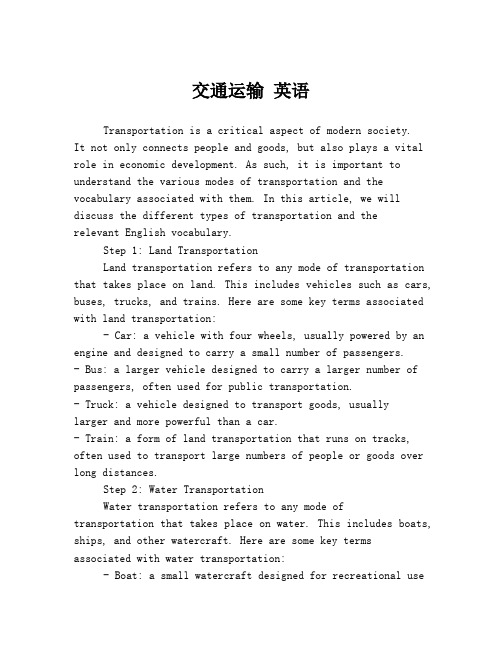
交通运输英语Transportation is a critical aspect of modern society.It not only connects people and goods, but also plays a vital role in economic development. As such, it is important to understand the various modes of transportation and the vocabulary associated with them. In this article, we will discuss the different types of transportation and therelevant English vocabulary.Step 1: Land TransportationLand transportation refers to any mode of transportation that takes place on land. This includes vehicles such as cars, buses, trucks, and trains. Here are some key terms associated with land transportation:- Car: a vehicle with four wheels, usually powered by an engine and designed to carry a small number of passengers.- Bus: a larger vehicle designed to carry a larger number of passengers, often used for public transportation.- Truck: a vehicle designed to transport goods, usuallylarger and more powerful than a car.- Train: a form of land transportation that runs on tracks, often used to transport large numbers of people or goods over long distances.Step 2: Water TransportationWater transportation refers to any mode oftransportation that takes place on water. This includes boats, ships, and other watercraft. Here are some key terms associated with water transportation:- Boat: a small watercraft designed for recreational useor transport on smaller bodies of water.- Ship: a larger watercraft designed for transport across larger bodies of water, often used for commercial purposes.- Ferry: a type of boat used to transport passengers, vehicles, or goods across a body of water.- Cruise ship: a large ship designed for leisure travel, usually accommodating thousands of passengers and offering various amenities.Step 3: Air TransportationAir transportation refers to any mode of transportation that takes place in the air. This includes airplanes and helicopters. Here are some key terms associated with air transportation:- Airplane: a powered flying vehicle with wings and a fixed fuselage, designed for transport of passengers or goods. - Helicopter: a type of aircraft that is lifted and propelled by rotors, often used for emergency services or transport to remote locations.- Airport: a place where airplanes take off and land, often with various facilities for passengers and aircraft.- Runway: a flat strip of land or pavement at an airportwhere aircraft take off and land.In conclusion, transportation is an essential part of life, and it is important to understand the various modes of transportation and the related vocabulary. Whether you are travelling on land, water, or air, knowing the appropriate terminology can help you navigate more effectively and communicate more clearly.。
五种运输方式的英语表达

五种运输方式的英语表达五种运输方式的英语表达1. Land transportation- Road transport: using vehicles to transport goods or people on roads, highways, or motorways. Example: The company uses trucks for road transport to deliver their products to different cities.- Rail transport: using trains to transport goods or people on railways. Example: The rail transport system is more efficient for transporting heavy goods over long distances. - Pipeline transport: using pipelines to transport liquids or gases over long distances. Example: The oil industry uses pipeline transport to move crude oil from one place to another.2. Water transportation- Sea transport: using ships or boats to transport goods or people over long distances on the sea. Example: The company exports their products to other countries by sea transport. - Inland waterway transport: using rivers, canals, or lakes to transport goods or people. Example: The transport of goods by inland waterways is more economical and environmentally friendly.3. Air transportation- Air transport: using airplanes or helicopters to transport goods or people over long distances in the air. Example: The company uses air transport to deliver their products to other countries quickly.- Space transportation: using spacecraft to transport peopleor goods into space. Example: The space transportation industry is growing rapidly with the development of space tourism.4. Cable transportation- Cable transport: using cables to transport goods or people over long distances. Example: The cable transport system is commonly used in mountainous areas for tourism or transportation.5. Pipeline transportation- Pipeline transport: using pipelines to transport liquids or gases over long distances. Example: The oil industry uses pipeline transport to move crude oil from one place to another.In conclusion, there are various ways to transport goods or people, and each has its own advantages and disadvantages. The choice of transportation mode depends on factors such as distance, speed, cost, and environmental impact.。
英语版运输方式PPT课件
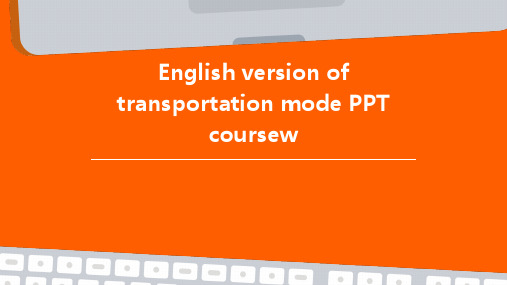
Modern commercial aircraft are capable of traveling at high speeds and are more effective in terms of fuel consumption and flight time
Charter Flight Service
Private jet
rentals
Individuals or organizations can rent private jets for a specific flight, commonly for business or VIP travel
Typical vehicles include oil pipelines and gas pipelines Pipeline transportation is suitable for the transportation of large quantities of liquid or gas goods over long distances
English version of transportation mode PPT
coursew
目录
• Introduction • Land transportation • Maritime transportation • Air transport • Future transportation modes
要点一
Vertical take off and landing
Helicopters have the ability to take off and land vertically, making them suitable for use in areas with limited space or in confined locations
交通工具英语单词

交通工具英语单词航空器(Aircraft)- Airplane:飞机- Helicopter:直升机- Balloon:气球- Drone:无人机- Glider:滑翔机- Jet:喷气式飞机- Zeppelin:齐柏林飞艇陆上交通工具(Land Transportation)- Car:汽车- Bicycle:自行车- Motorcycle:摩托车- Bus:公交车- Train:火车- Tram:有轨电车- Taxi:出租车水上交通工具(Water Transportation)- Ship:船- Sailboat:帆船- Yacht:游艇- Canoe:划艇- Submarine:潜水艇- Ferry:渡轮- Speedboat:快艇太空交通工具(Space Transportation)- Space shuttle:航天飞机- Rocket:火箭- Satellite:卫星- Lunar lander:登月器- Space capsule:航天舱- Space station:空间站- Space probe:探测器城市交通工具(Urban Transportation)- Metro:地铁- Light rail:轻轨列车- Monorail:单轨列车- Tram:电车- Bicycle sharing:共享单车- Scooter:滑板车/踏板车- Roller skates:溜冰鞋农村交通工具(Rural Transportation)- Tractor:拖拉机- Horse and carriage:马车- Cart:手推车- Bicycle:自行车- Motorcycle:摩托车- ATV (All-Terrain Vehicle):全地形车- Ox cart:黄牛车以上是一些常见的交通工具英语单词,希望能对您有所帮助。
请根据您的需求自由修改使用,方便记忆和交流。
运输英语知识点总结高中
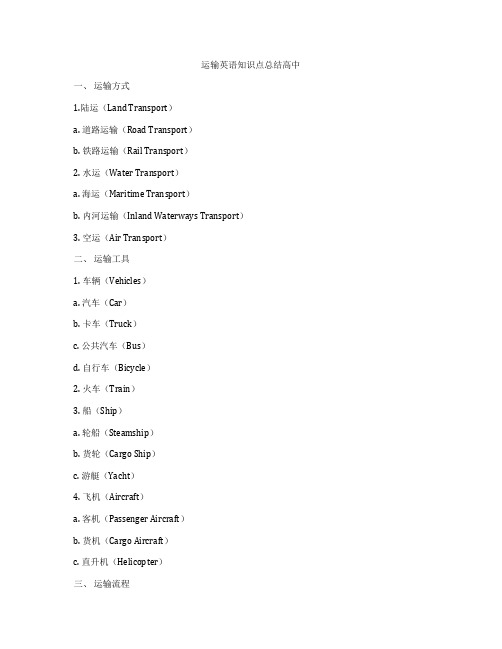
运输英语知识点总结高中一、运输方式1.陆运(Land Transport)a. 道路运输(Road Transport)b. 铁路运输(Rail Transport)2. 水运(Water Transport)a. 海运(Maritime Transport)b. 内河运输(Inland Waterways Transport)3. 空运(Air Transport)二、运输工具1. 车辆(Vehicles)a. 汽车(Car)b. 卡车(Truck)c. 公共汽车(Bus)d. 自行车(Bicycle)2. 火车(Train)3. 船(Ship)a. 轮船(Steamship)b. 货轮(Cargo Ship)c. 游艇(Yacht)4. 飞机(Aircraft)a. 客机(Passenger Aircraft)b. 货机(Cargo Aircraft)c. 直升机(Helicopter)三、运输流程1. 订舱(Booking)2. 装载(Loading)3. 运输(Transportation)4. 卸货(Unloading)5. 交付(Delivery)四、运输英语专业词汇1. 运输(Transportation)2. 装卸货物(Loading and unloading cargo)3. 航空公司(Airline)4. 航线(Air route)5. 港口(Port)6. 仓库(Warehouse)7. 保险单(Insurance Policy)8. 物流(Logistics)9. 运输费用(Freight)10. 运输承运人(Carrier)五、运输文书1. 运输单据(Transportation documents)a. 提单(Bill of Lading)b. 装箱单(Packing List)c. 发票(Invoice)d. 装货清单(Loading List)e. 舱单(Manifest)2. 运输合同(Transportation Contract)a. 运输合同(Transportation Contract)b. 保险合同(Insurance Contract)六、运输保险1. 货物保险(Cargo Insurance)a. 一般保险(General Average Insurance)b. 危险货物保险(Hazardous Cargo Insurance)c. 运输保险单(Carriage Insurance Policy)2. 责任保险(Liability Insurance)a. 运输责任险(Transport Liability Insurance)七、运输术语1. 装卸货物操作(Loading and unloading operations)a. 装货(Loading)b. 卸货(Unloading)2. 舱位(Space)a. 仓位(Cargo Space)b. 座位(Seat)3. 运输时间(Transportation time)a. 预计到达时间(Estimated Time of Arrival,ETA)b. 预计出发时间(Estimated Time of Departure,ETD)4. 运输方式(Mode of Transportation)a. 整箱(Full Container Load,FCL)b. 拼箱(Less than Container Load,LCL)五、运输英语句子1. We have booked the cargo space for the shipment.2. The carrier is responsible for the transportation of the goods.3. The packing list and invoice should be submitted to the customs.4. The ETA of the vessel is subject to change due to weather conditions.5. The cargo will be unloaded at the designated port according to the contract.6. The air route has been scheduled for the transportation of the passengers.7. The cargo insurance policy covers the loss of the goods during the transportation process.8. The transportation of the hazardous cargo requires special precautions and documentation.9. The logistics company is responsible for the coordination of the transportation process.10. The transportation contract specifies the terms and conditions of the shipment.六、运输英语常见对话1. A: I would like to book a cargo space for the shipment to New York.B: Sure, could you please provide the details of the cargo and the desired transportation time?A: The cargo consists of 20 containers of electronics and we need the shipment to be delivered within 10 days.B: I will arrange the transportation and provide you with the necessary documents for the shipment.2. A: The cargo has arrived at the port, when will the unloading process begin?B: The unloading will commence tomorrow morning as soon as the vessel docks at the designated pier.A: I need to make arrangements for the transportation of the goods to the warehouse.B: We will assist you in the coordination of the transportation and provide the necessary support.3. A: The transportation of the passengers has been scheduled for the weekend, have you confirmed the seats?B: Yes, the seats have been booked for the passengers and the flight is expected to depart on time.A: I need to arrange for the transportation of the passengers from the airport to the hotel. B: We will provide the necessary transportation services and ensure a smooth transition for the passengers.4. A: The cargo insurance policy for the shipment has been issued, do you have any specific instructions for the transportation?B: Yes, please ensure that the goods are properly packaged and labeled for the transportation process.A: I will make sure that the goods are in compliance with the transportation regulations and requirements.B: Thank you, we appreciate your cooperation in the transportation of the goods.七、运输英语写作Dear Sir/Madam,We would like to book a cargo space for the shipment of our goods to the designated port. The cargo consists of [description of the goods] and we require the transportation to be completed within [desired time frame].We kindly request your assistance in arranging the transportation and providing the necessary documentation for the shipment.Thank you for your attention to this matter and we look forward to your prompt response. Sincerely,[Your Name][Company Name][Contact Information]以上是一份运输英语知识点总结,希服可以帮到您。
各类油品运输方式流程解析

各类油品运输方式流程解析1.油品运输方式有陆运、水运和管道运输。
(Oil transportation methods include land transport, water transport, and pipeline transport.)2.陆运通常采用罐车运输,可以直接送达目的地。
(Land transportation is usually carried out by tank trucks, which can deliver directly to the destination.)3.罐车装载油品后需要遵守严格的安全规定和限速要求。
(Tank trucks need to comply with strict safety regulations andspeed limits after loading oil products.)4.水运是油品远距离运输的常用方式,可以通过海运或内河运输。
(Water transport is a common method for long-distance oil transportation, which can be carried out by sea or inland waterway.)5.油轮或驳船通常用于海洋油品运输,而集装箱船和散货船可以用于内河运输。
(Oil tankers or barges are commonly used formaritime oil transportation, while container ships and bulk carriers can be used for inland waterway transport.)6.水运油品需要严格遵守各种安全规定和防范措施,以应对可能的泄漏和污染。
(Water transport of oil products needs to strictly adhere to various safety regulations and preventive measures to cope with possible leaks and pollution.)7.管道运输是油品长距离、大规模运输的有效方式,具有高效、安全的特点。
陆运进口操作流程

陆运进口操作流程Importing goods through land transportation involves a complex process that requires careful planning and coordination. From customs clearance to final delivery, each step in the process must be carefully managed to ensure a smooth and efficient operation.陆运进口货物需要经过一个复杂的流程,需要仔细的计划和协调。
从清关到最终交付,每个步骤都必须被认真管理,以确保运作流畅高效。
One of the key steps in the land import process is customs clearance. This involves submitting the necessary documentation to the relevant authorities and paying any applicable duties and taxes. Failure to comply with customs regulations can result in delays and additional costs, so it's important to work with experienced customs brokers who can help navigate the various requirements.陆运进口流程中的一个关键步骤是清关。
这涉及向相关当局提交必要的文件,支付任何适用的关税和税款。
不遵守海关规定可能会导致延迟和额外成本,因此与有经验的报关代理合作很重要,他们可以帮助应对各种要求。
陆海空三用车作文400字

陆海空三用车作文400字英文回答:Land, sea, and air are three different modes of transportation that serve different purposes. Each mode of transportation has its own advantages and disadvantages.Land transportation, such as cars, buses, and trains, is the most common and convenient mode of transportationfor short distances. It allows people to travel from one place to another quickly and efficiently. In addition, land transportation is relatively inexpensive and readily available. For example, people can easily hail a taxi or take a bus to get to their destination. On the other hand, land transportation is often subject to traffic congestion, especially in urban areas. This can lead to delays and frustration for commuters.Sea transportation, such as ships and boats, is commonly used for transporting goods over long distances.It is an important mode of transportation for international trade. Sea transportation is cost-effective and can carry large quantities of cargo. Moreover, it is less affected by weather conditions compared to air transportation. However, sea transportation is relatively slow and can take weeks or even months to reach the destination. It is also notsuitable for transporting perishable goods.Air transportation, such as airplanes, is the fastest mode of transportation and is commonly used for long-distance travel. It allows people to reach theirdestination quickly, saving time and effort. Air travelalso offers comfort and convenience, with amenities such as in-flight entertainment and meals. However, air transportation is often more expensive compared to other modes of transportation. It is also subject to delays and cancellations due to weather conditions or technical issues.In conclusion, land, sea, and air transportation each have their own advantages and disadvantages. Land transportation is convenient and readily available, but can be affected by traffic congestion. Sea transportation iscost-effective for transporting goods over long distances, but is relatively slow. Air transportation is the fastest mode of transportation, but can be expensive and subject to delays. The choice of transportation mode depends on the specific needs and circumstances of the traveler.中文回答:陆地、海洋和空中是三种不同的交通方式,各有其优势和劣势。
各种各样的交通工具课文英语

各种各样的交通工具课文英语TransportationThere are various types of transportation available to people to travel from one place to another. These transportation modes can be categorized into land, water, and air travel. Let's explore some of these vehicles and their descriptions.Land Transportation:1. Car: Cars are one of the most common modes of transportation. They are private vehicles that run on roads and are ideal for short to medium distances.2. Bus: Buses are public vehicles that transport multiple passengers at once. They usually have fixed routes and stops.3. Train: Trains are large vehicles that run on railways. They are commonly used for long-distance travel and can carry a large number of passengers.4. Bicycle: Bicycles are human-powered vehicles with two wheels. They are environmentally friendly and suitable for short distances. Water Transportation:1. Ship: Ships are large vessels used for transporting goods and passengers across seas and oceans.2. Ferry: Ferries are boats that transport people and vehicles across bodies of water, such as rivers and lakes.3. Cruise Ship: Cruise ships are massive passenger vessels designed for leisure travel. They offer various amenities and entertainment options on board.Air Transportation:1. Airplane: Airplanes are powered fixed-wing aircraft that can travel long distances through the air. They are the fastest means of transportation.2. Helicopter: Helicopters are rotary-wing aircraft that can take off and land vertically. They are commonly used for short-distance travel or in emergencies.These are just a few examples of the various transportation modes available. Each mode has its own advantages and is used based on personal preferences, distance, cost, and purpose of travel.。
关于运输品种的多样性英语作文
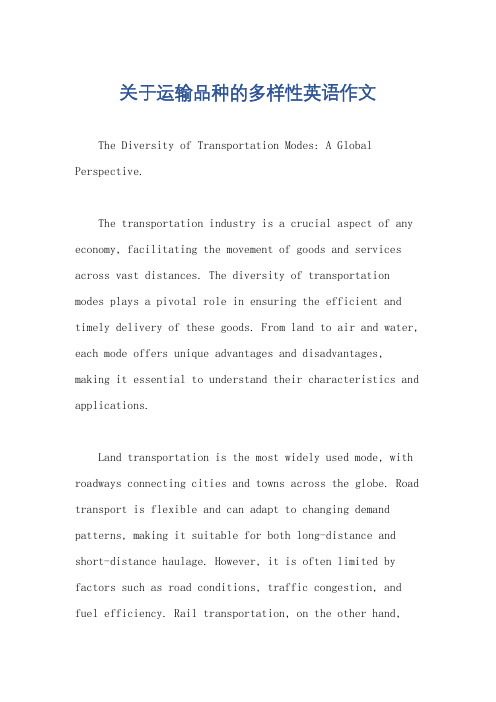
关于运输品种的多样性英语作文The Diversity of Transportation Modes: A Global Perspective.The transportation industry is a crucial aspect of any economy, facilitating the movement of goods and services across vast distances. The diversity of transportation modes plays a pivotal role in ensuring the efficient and timely delivery of these goods. From land to air and water, each mode offers unique advantages and disadvantages, making it essential to understand their characteristics and applications.Land transportation is the most widely used mode, with roadways connecting cities and towns across the globe. Road transport is flexible and can adapt to changing demand patterns, making it suitable for both long-distance and short-distance haulage. However, it is often limited by factors such as road conditions, traffic congestion, and fuel efficiency. Rail transportation, on the other hand,offers higher speeds and lower operating costs for bulk cargo, but it requires significant infrastructure investments and fixed routes.Water transportation, particularly maritime shipping, is the most cost-effective mode for bulk cargoes over long distances. Ships can carry vast amounts of cargo, and the cost per unit of weight or volume is significantly lower than other modes. However, water transportation is slower and depends on weather conditions and port infrastructure. River and canal shipping provide an alternative for inland transportation, especially in regions where rivers are navigable.Air transportation is the fastest mode but also the most expensive. It is ideal for high-value, time-sensitive goods or for connecting remote areas where other modes are not feasible. Air cargo services have become increasingly important in the global supply chain, especially for perishable goods and high-tech products. However, air transportation is limited by factors such as airport capacity, weather conditions, and fuel costs.The diversity of transportation modes also extends to specialized services such as pipeline transportation, which is primarily used for liquids and gases like oil and natural gas. Pipelines offer secure and efficient transportation for these commodities, reducing the risks associated with road or rail transport.The choice of transportation mode depends on various factors, including the nature of the cargo, distance, time constraints, and costs. Multimodal transportation, which combines different modes to optimize efficiency and cost, has become increasingly popular. For example, containerships carry cargo by sea to a port, where it is then transferred to rail or road for the final leg of the journey.In conclusion, the diversity of transportation modes is crucial for ensuring the smooth functioning of global trade and supply chains. Each mode offers unique advantages and disadvantages, making it essential to understand and leverage their respective strengths. As technologiescontinue to evolve, new modes of transportation may emerge, further enhancing the diversity and efficiency of the transportation industry.。
怎么描述运输情况英文作文
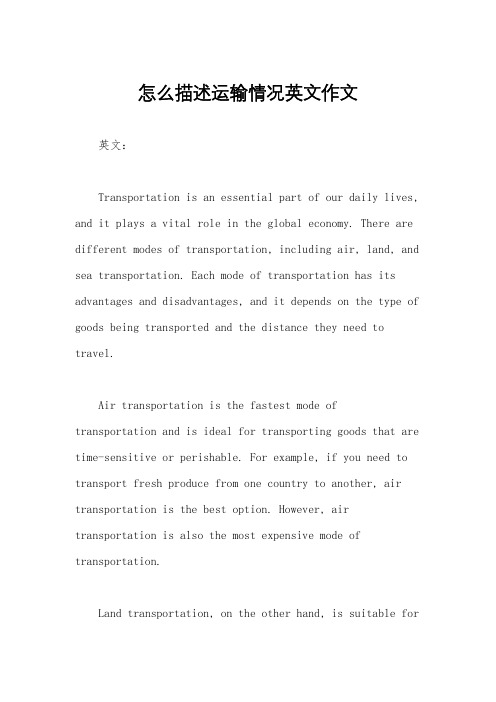
怎么描述运输情况英文作文英文:Transportation is an essential part of our daily lives, and it plays a vital role in the global economy. There are different modes of transportation, including air, land, and sea transportation. Each mode of transportation has its advantages and disadvantages, and it depends on the type of goods being transported and the distance they need to travel.Air transportation is the fastest mode oftransportation and is ideal for transporting goods that are time-sensitive or perishable. For example, if you need to transport fresh produce from one country to another, air transportation is the best option. However, air transportation is also the most expensive mode of transportation.Land transportation, on the other hand, is suitable fortransporting goods within a country or a region. It includes trucks, trains, and buses. Trucks are the most common mode of land transportation, and they are ideal for transporting goods that are not time-sensitive or perishable. Trains are suitable for transporting goods over long distances, and they are also more environmentally friendly than trucks. Buses are commonly used for transporting passengers, but they can also be used for transporting goods over short distances.Sea transportation is the most cost-effective mode of transportation, and it is ideal for transporting large quantities of goods over long distances. It includes cargo ships, tankers, and container ships. Cargo ships are used for transporting dry goods, tankers are used for transporting liquids, and container ships are used for transporting goods in containers. However, sea transportation is also the slowest mode of transportation, and it is not suitable for transporting time-sensitive or perishable goods.中文:运输是我们日常生活中不可或缺的一部分,它在全球经济中发挥着至关重要的作用。
人教版小学一年级导学案学习描述交通工具的特点的英文词汇

人教版小学一年级导学案学习描述交通工具的特点的英文词汇The Characteristics of Transportation Vehicles - A Study Guide for Grade 1 StudentsIntroduction:In this study guide, we will explore the various characteristics of transportation vehicles in English. This will help Grade 1 students develop their vocabulary related to transportation and understand the distinctive features of different vehicles.Air Transportation:Airplanes: Airplanes are powerful vehicles that can fly through the air. They have wings, an engine, and a cockpit where the pilot controls the plane. Airplanes are commonly used for long-distance travel and can carry a large number of passengers.Helicopters: Helicopters are unique because they can take off and land vertically. They have rotating blades on top, which enable them to stay in the air and move in any direction. Helicopters are often used for rescue missions and transportation to remote areas.Water Transportation:Boats: Boats are vehicles that move on water. They can be small or large, and their size determines their purpose. Some boats are used for fishing or leisure activities, while others are designed for transportation of goods or people. Boats can travel in rivers, lakes, and oceans.Ships: Ships are large boats that are specifically built for long journeys across the sea. They are equipped with facilities to carry large quantities of cargo or a large number of passengers. Ships are essential for international trade and travel.Land Transportation:Cars: Cars are the most common mode of transportation on land. They have four wheels and an engine, which enables them to move quickly on roads. Cars are used for personal transportation and can accommodate a few passengers.Bicycles: Bicycles are human-powered vehicles that have two wheels and pedals. They provide an eco-friendly mode of transportation and are commonly used for short distances. Bicycles are a healthy and affordable option for individuals.Trains: Trains are vehicles that run on tracks and are powered by engines. They can transport large numbers of passengers or goods over long distances. Trains are famous for their speed and efficiency, making them a popular choice for public transportation.Conclusion:Understanding the characteristics of transportation vehicles is important for Grade 1 students to build their English vocabulary. By learning about the distinctive features of airplanes, helicopters, boats, ships, cars, bicycles, and trains, students can express themselves effectively and comprehend transportation-related discussions. This knowledge will also enable them toappreciate the different modes of transportation available in our modern world.。
英语实用交通工具作文
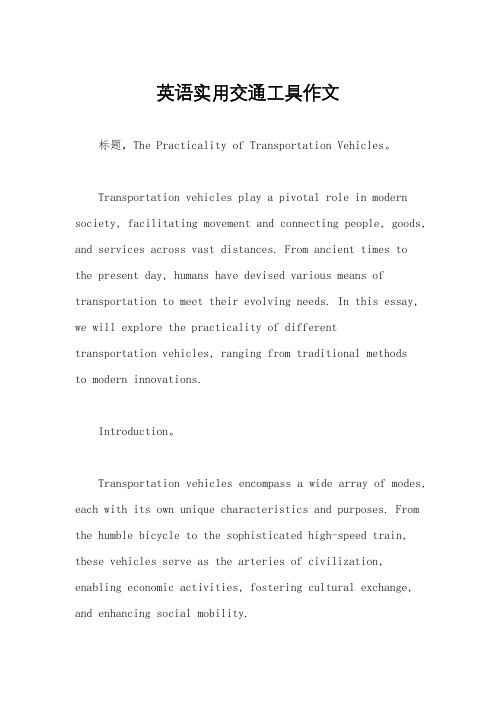
英语实用交通工具作文标题,The Practicality of Transportation Vehicles。
Transportation vehicles play a pivotal role in modern society, facilitating movement and connecting people, goods, and services across vast distances. From ancient times to the present day, humans have devised various means of transportation to meet their evolving needs. In this essay, we will explore the practicality of differenttransportation vehicles, ranging from traditional methodsto modern innovations.Introduction。
Transportation vehicles encompass a wide array of modes, each with its own unique characteristics and purposes. From the humble bicycle to the sophisticated high-speed train, these vehicles serve as the arteries of civilization, enabling economic activities, fostering cultural exchange, and enhancing social mobility.1. Land Transportation。
交通工具分类的英语作文

Transportation is a vital part of our daily lives, allowing us to travel to work, school, and various other destinations. There are several types of transportation, each with its own advantages and disadvantages. In this essay, I will discuss the different categories of transportation and their uses.1. Land Transportation: This includes cars, buses, trains, and bicycles. Cars are the most common mode of land transportation, offering convenience and flexibility. Buses are a more economical choice for those who want to save money or reduce their carbon footprint. Trains are ideal for longdistance travel and are often more environmentally friendly than cars. Bicycles are a healthy and ecofriendly option, perfect for short commutes and exercise.2. Air Transportation: Airplanes are the fastest way to travel long distances, making them ideal for international travel or when time is of the essence. They offer a comfortable and efficient way to get from one place to another, although they can be more expensive than other forms of transportation.3. Water Transportation: This includes boats, ferries, and ships. Water transportation is often used for leisure activities like boating or fishing, but it can also be a practical way to travel, especially in coastal areas or between islands. Ferries are a common mode of transportation for short distances across bodies of water.4. Public Transportation: Public transportation systems, such as buses, subways, and trams, are designed to move large numbers of people efficiently within cities and towns. They are typically more affordable than owning a car and can help reduce traffic congestion and air pollution.5. Private Transportation: This category includes privately owned vehicles like cars, motorcycles, and recreational vehicles. Private transportation offers the most flexibility and control over ones travel plans but can be more expensive in terms of purchase, maintenance, and fuel costs.6. Emerging Transportation Technologies: With advancements in technology, new modes of transportation are emerging. Electric cars, selfdriving vehicles, and even flying cars are on the horizon, promising to revolutionize the way we travel.Each type of transportation has its place in our society, and the choice of which to use often depends on factors such as distance, cost, time, and personal preference. As we continue to develop new technologies and methods of transportation, its important to consider the environmental impact and the convenience they provide to our daily lives.。
2020-2021学年牛津译林版英语九年级下册词汇创新拓展学习法(第51组)

词汇创新拓展学习法第51组land英音:/lænd/美音:/lænd/1.n.陆地, 陆上, 地面2.国家, 国土3.土地, 田地; 地产4.乡村生活5.vt. & vi. (使)登岸, (使)下船, (使)着陆6.vt.自船上卸下7.获得时态: landed, landing, lands词组| 习惯用语lands n. [农] 土地(land的复数形式);平原;平面; v. 使登陆(land的第三人称单数形式); n. (Lands)人名;(葡)兰茨;Landers n. 兰德斯(男子名)land operation土地经营land attack着陆攻击ancient land古陆mineral land矿地;采矿业用地land art大地艺术词汇创新拓展学习法land power陆军力量land resource [经] 土地资源land lot地段; 地块;网络短语:Lands凸面; 赤西仁; 平原; 处境地政局;landings出煤量; 起落数;Land Land Rover国家路虎; 路虎国; 路虎土地;CIF Landed CIF Landed卸到岸上land transportation land carriage陆地上交通运输arable land cultivable land可耕地landing discursiveness着陆散布度Free Land自由地带; 自由的土地; 自由人; 免费的土地;land rocky-desertification土地石漠化英语例句库1.Real property is land and things immovably attached to the land.1.不动产指的是土地以及土地上附着物.2.The military aircraft circled over the landing strip for some time before it landed.2.这架军用飞机着陆前在着陆跑道上空盘旋了一阵。
